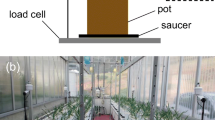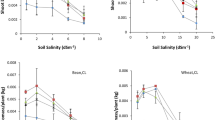Abstract
We used a water-centred framework (yield = transpiration × transpiration efficiency × harvest index) to investigate the effect of soil salinity on growth and yield of wheat and barley. Our working hypothesis is that salinity reduces transpiration proportionally more than transpiration efficiency. We established a glasshouse experiment with the factorial combination of four varieties (wheat: Janz, Krichauff; barley: Mundah, Keel) and three soil treatments: a control with no NaCl added, and NaCl added to achieve soil EC1:5 0.75 dS m−1 and 1.5 dS m−1. Pot-grown plants were watered to weight to determine transpiration and shoot dry matter was determined using a non-destructive image analysis system. Consistent with our hypothesis, salinity reduced transpiration (30–60%) proportionally more than transpiration efficiency (0–35%); transpiration accounted for 90% of the variation in shoot growth across varieties and treatments. Against this pattern, there were time- and variety-dependent responses. The rate of leaf appearance and the transpiration efficiency of Janz, Krichauff and Keel showed a two-stage response to salinity. In stage 1, salt-stressed plants maintained rate of leaf appearance and transpiration efficiency close to or slightly below those of the controls. After a clear break point where the slope changed, stage 2 was characterised by a substantial reduction in both traits. Stage 2 was not evident in salt-stressed Mundah, which maintained a relatively high rate of leaf appearance and transpiration efficiency. Across species, harvest index increased from 0.40 in controls to 0.47 at 0.75 dS m−1. Harvest index of plants grown at 1.5 dS m−1 was unaffected in wheat, and was reduced in barley. We propose that an understanding of the effect of salinity on crop development, growth and yield requires integration of low-level traits in a framework of resource capture, resource-use efficiency and plant allocation. Osmotic stress tolerance, Na+ exclusion, and tissue tolerance to accumulated Na+ would improve yield of salt-stressed crops to the extent that these traits contribute to the maintenance of water uptake and harvest index.







Similar content being viewed by others
References
Abdolzadeh A, Shima K, Lambers H, Chiba K (2008) Change in uptake, transport and accumulation of ions in Nerium oleander (Rosebay) as affected by different nitrogen sources and salinity. Ann Bot 102:735–746
Abeledo LG, Calderini DF, Slafer GA (2004) Leaf appearance, tillering and their coordination in old and modern barleys from Argentina. Field Crops Res 86:23–32
Ben-Porath A, Baker DN (1990) Tap-root restriction effects on growth, earliness, and dry weight partitioning of cotton. Crop Sci 30:809–814
Brueck H (2008) Effects of nitrogen supply on water-use efficiency of higher plants. J Plant Nutr Soil Sci 171:210–219
Cabrera-Bosquet L, Albrizio R, Araus JL, Nogues S (2009) Photosynthetic capacity of field-grown durum wheat under different N availabilities: a comparative study from leaf to canopy. Environ Exp Bot 67:145–152
Calderini DF, Miralles DJ, Sadras VO (1996) Appearance and growth of individual leaves as affected by semidwarfism in isogenic lines of wheat. Ann Bot 77:583–589
Chow W, Ball M, Anderson J (1990) Growth and photosynthetic responses of spinach to salinity: implications of K+ nutrition for salt tolerance. Funct Plant Biol 17:563–578
Denison RF (2009) Darwinian agriculture: real, imaginary and complex trade-offs as constraints and opportunities. In: Sadras VO, Calderini DF (eds) Crop physiology: applications for genetic improvement and agronomy. Academic Press, San Diego, pp 215–234
Esmaili E, Kapourchal SA, Malakouti MJ, Homaee M (2008) Interactive effect of salinity and two nitrogen fertilizers on growth and composition of sorghum. Plant Soil Environ 54:537–546
Gambín BL, Borrás L (2009) Resource distribution and the trade-off between seed number and seed weight: a comparison across crop species. Ann Appl Biol 156:91–102
Ghiglione HO et al (2008) Autophagy regulated by day length determines the number of fertile florets in wheat. Plant J 55:1010–1024
Grewal HS (2010) Water uptake, water use efficiency, plant growth and ionic balance of wheat, barley, canola and chickpea plants on a sodic vertosol with variable subsoil NaCl salinity. Agric Water Manage 97:148–156
Halvorson AD, Reule CA (1976) Controlling saline seeps by intensive cropping of recharge areas. Regional Saline Seep Control Symposium Proceedings. Bulletin No 1132, Montana State University (Mont.):115–124
Holloway RE, Alston AM (1992) The effects of salt and boron on growth of wheat. Aust J Agric Res 43:987–1001
James RA, Munns R, von Caemmerer S, Trejo C, Miller C, Condon T (2006) Photosynthetic capacity is related to the cellular and subcellular partitioning of Na+, K+ and Cl– in salt-affected barley and durum wheat. Plant Cell Environ 29:2185–2197
Jamieson PD, Brooking IR, Porter JR, Wilson DR (1995) Prediction of leaf appearance in wheat: a question of temperature. Field Crops Res 41:35–44
Jarvis P (1995) Scaling processes and problems. Plant Cell Environ 18:1079–1089
Jarvis P, McNaughton K (1986) Stomatal control of transpiration: scaling up from leaf to region. Adv Ecol Res 15:1–49
Katerji N, van Horn JW, Hamdi A, Mastrorilli M, Mou Karzel E (1997) Osmotic adjustment of sugar beet in response to soil salinity and its influence on stomatal conductance, growth and yield. Agric Water Manage 34:57–69
Katerji N, Mastrorilli M, van Hoorn JW, Lahmer FZ, Hamdy A, Oweis T (2009) Durum wheat and barley productivity in saline-drought environments. Eur J Agron 31:1–9
Kramer PJ, Boyer JS (1995) Water relations of plants and soils. Academic Press, San Diego
Lemaire G, Gastal F (2009) Quantifying crop responses to nitrogen deficiency and avenues to improve nitrogen-use efficiency. In: Sadras VO, Calderini DF (eds) Crop physiology: applications for genetic improvement and agronomy. Academic Press, San Diego, pp 171–211
Long NR et al (2003) Mapping and QTL analysis of the barley population Mundah x Keel. Aust J Agric Res 54:1163–1171
Lu C, Qiu N, Wang B, Zhang J (2003) Salinity treatment shows no effects on photosystem II photochemistry, but increases the resistance of photosystem II to heat stress in halophyte Suaeda salsa. J Exp Bot 54:851–860
Malagoli P, Britto DT, Schulze LM, Kronzucker HJ (2008) Futile Na+ cycling at the root plasma membrane in rice (Oryza sativa L.): kinetics, energetics, and relationship to salinity tolerance. J Exp Bot 59:4109–4117
Manschadi AM, Christopher Jd P, Hammer GL (2006) The role of root architectural traits in adaptation of wheat to water-limited environments. Funct Plant Biol 33:823–837
McCree KJ, Richardson SG (1987) Salt increases the water-use efficiency in water stressed plants. Crop Sci 27:543–547
Monteith JL (1977) Climate and efficiency of crop production in Britain. Philos Trans R Soc London Ser B 281:277–294
Munns R, Tester M (2008) Mechanisms of salt tolerance. Annu Rev Plant Biol 59:651–681
Passioura J (1977) Grain yield, harvest index and water use of wheat. J Aust Inst Agric Sci 43:117–120
Passioura JB (2006) The perils of pot experiments. Funct Plant Biol 33:1075–1079
Rajendran K, Tester M, Roy SJ (2009) Quantifying the three main components of salinity tolerance in cereals. Plant Cell Environ 32:237–249
Rawson HM (1986) Gas-exchange and growth in wheat and barley grown in salt. Aust J Plant Physiol 13:475–489
Reynolds M, Tuberosa R (2008) Translational research impacting on crop productivity in drought-prone environments. Curr Opin Plant Biol 11:171–179
Richards RA (1992) Increasing salinity tolerance of grain crops: Is it worthwhile? Plant Soil 146:89–98
Richards RA (2006) Physiological traits used in the breeding of new cultivars for water-scarce environments. Agric Water Manage 80:197–211
Rodriguez D, Nuttall J, Sadras VO, van Rees H, Armstrong R (2006) Impact of subsoil constraints on wheat yield and gross margin on fine-textured soils of the southern Victorian Mallee. Aust J Agric Res 57:355–365
Sadras VO (2007) Evolutionary aspects of the trade-off between seed size and number in crops. Field Crops Res 100:125–138
Sadras VO (2009) Does partial root-zone drying improve irrigation water productivity in the field? A meta-analysis. Irrig Sci 27:183–190
Sadras VO, Connor DJ (1991) Physiological basis of the response of harvest index to the fraction of water transpired after anthesis. A simple model to estimate harvest index for determinate species. Field Crops Res 26:227–239
Sadras VO, Denison RF (2009) Do plant parts compete for resources? An evolutionary perspective. New Phytol 183:565–574
Sadras VO, Villalobos FJ, Fereres E (1993) Leaf expansion in field-grown sunflower in response to soil and leaf water status. Agron J 85:564–570
Sadras VO, Roget DK, O’Leary GJ (2002) On-farm assessment of environmental and management constraints to wheat yield and rainfall use efficiency in the Mallee. Aust J Agric Res 53:587–598
Sadras VO, O’Leary GJ, Roget DK (2005) Crop responses to compacted soil: capture and efficiency in the use of water and radiation. Field Crops Res 91:131–148
Shani U, Ben-Gal A (2005) Long-term response of grapevines to salinity: osmotic effects and ion toxicity. Am J Enol Vitic 56:148–154
Sinclair TR, Muchow RC (1999) Radiation use efficiency. Adv Agron 65:215–265
Sinclair TR, Purcell LC, Sneller CH (2004) Crop transformation and the challenge to increase yield potential. Trends Plant Sci 9:70–75
Smith CC, Fretwell SD (1974) The optimal balance between size and number of offspring. Am Nat 108:499–506
Steduto P, Albrizio R (2005) Resource use efficiency of field-grown sunflower, sorghum wheat and chickpea. II Water use efficiency and comparison with radiation use efficiency. Agric For Meteorol 130:269–281
Steduto P, Hsiao T, Fereres E (2007) On the conservative behavior of biomass water productivity. Irrig Sci 25:189–207
Taleisnik E, Rodríguez AA, Bustos D, Erdei L, Ortega L, Senn ME (2009) Leaf expansion in grasses under salt stress. J Plant Physiol 166:1123–1140
Turkan I, Demiral T (2009) Recent developments in understanding salinity tolerance. Environ Exp Bot 67:2–9
Valle SR, Pinochet D, Calderini DF (2009) Al toxicity effects on radiation interception and radiation use efficiency of Al-tolerant and Al-sensitive wheat cultivars under field conditions. Field Crops Res 114:343–350
Wise RR et al (1990) Investigation of the limitations to photosynthesis induced by leaf water deficits in field-grown sunflower (Helianthus annus L.). Plant Cell Environ 13:923–931
Zhu J, Meinzer FC (1999) Efficiency of C4-photosynthesis in Atriplex lentiformis under salinity stress. Funct Plant Biol 26:79–86
Acknowledgements
This paper derived from Brett Harris’ Honours Thesis (University of South Australia) and was partially funded by the Grains Research and Development Corporation of Australia (DAS 00089), the Australian Research Council and River Murray Program. We thank the scientific and technical assistance of Bettina Berger, James Eddes, Chris Lawson, Yuri Shavrukov and Ehsan Tavakkoli.
Author information
Authors and Affiliations
Corresponding author
Additional information
Responsible Editor: Timothy J. Flowers.
Rights and permissions
About this article
Cite this article
Harris, B.N., Sadras, V.O. & Tester, M. A water-centred framework to assess the effects of salinity on the growth and yield of wheat and barley. Plant Soil 336, 377–389 (2010). https://doi.org/10.1007/s11104-010-0489-9
Received:
Accepted:
Published:
Issue Date:
DOI: https://doi.org/10.1007/s11104-010-0489-9




